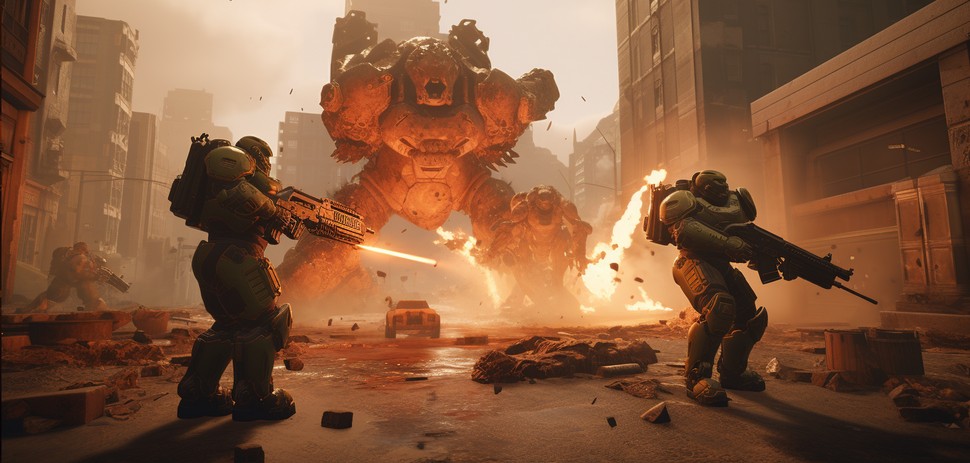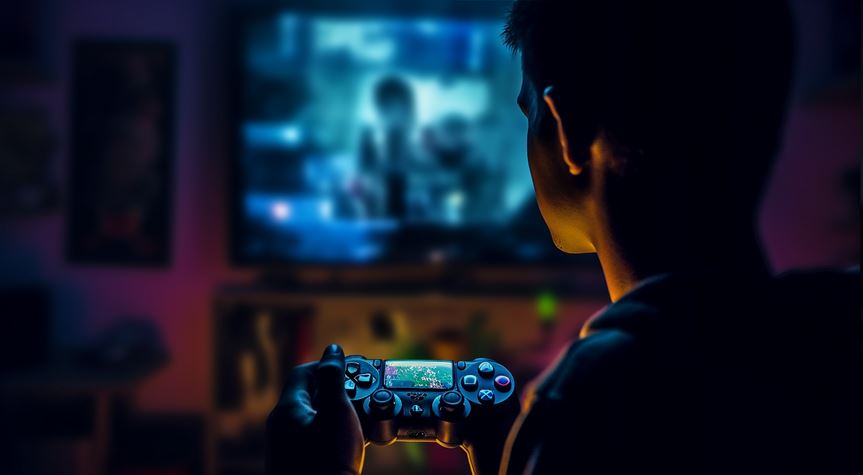From the first pixelated games of the late 20th century to today’s hyper-realistic and expansive virtual worlds, video gaming has come a long way. As this world of gaming has grown, several factors have been instrumental in deciding a game’s success and playability.
Among these, the Frames Per Second (FPS) has stood out as a significant element. Its role in how we experience games has only grown in importance and intricacy over time.
Brief overview of what FPS is
Every moving image, be it a movie or a video game, is composed of numerous still images, often referred to as “frames”. When these frames are displayed rapidly in succession, it creates the illusion of motion.
The term ‘Frames Per Second’ or FPS denotes the number of these individual images that are shown within a single second. The higher the FPS, the smoother and more fluid the motion appears. In gaming, this fluidity is critical as it influences the responsiveness and the visual experience of the game.
The evolution of FPS in video game history
In the embryonic stage of video games, hardware constraints meant games often operated at lower FPS. It wasn’t uncommon for games to run at 20 or 30 FPS. As technology advanced, so did the hardware capabilities, allowing games to run at higher frame rates. The transition from 2D to 3D graphics in the 90s was a pivotal moment, necessitating the need for better FPS for smoother rotations and movements.
The 21st century saw the mainstreaming of 60 FPS, especially with the growth of competitive gaming, where precision and responsiveness became paramount. Today, with advancements in display technology and powerful gaming rigs, we’re even seeing games boasting frame rates in the range of 120 FPS to 240 FPS, offering unparalleled smoothness.
Basics of FPS and Why It Matters
In the vast universe of video gaming, certain metrics rise to the top as vital indicators of quality and playability. FPS is undeniably one such metric. To truly appreciate its significance, we need to delve deep into its basic understanding, and recognize why it’s so pivotal in gaming, especially when compared to other visual mediums like film.
Definition of Frames Per Second (FPS)
At the heart of any visual motion, be it a cinematic reel or a virtual in-game chase, is the concept of frames. A frame is a still image, and when numerous such images are displayed in swift succession, it results in the perception of motion. ‘Frames Per Second’, commonly abbreviated to FPS, quantifies this motion by indicating the number of individual frames shown within a one-second timeframe. Higher FPS values suggest smoother and more fluidic visuals, offering a lifelike rendition of motion.
Differentiating between FPS in gaming and film
On the surface, both movies and video games use FPS to dictate motion fluidity. However, the application and importance of FPS differ significantly between these mediums.
Films typically use a standard of 24 FPS, a rate that historically balanced the cost of film stock with the perception of lifelike motion.
Our brains fill in the ‘gaps’, resulting in smooth motion, even at these seemingly lower frame rates.
Video games, on the other hand, are an interactive medium. This interactivity means that the motion isn’t predefined, as it is in films. Players react in real-time, and the game responds accordingly. Therefore, higher FPS values like 60 or even 120 offer a significant advantage by rendering smoother visuals and ensuring the game reacts instantly to player actions.
The interplay between FPS, resolution, and graphics quality
FPS doesn’t stand alone in the realm of gaming graphics. It’s part of a trio, along with resolution and graphic quality, that defines a gamer’s visual experience. Resolution refers to the number of pixels displayed on the screen, impacting the sharpness and clarity of the image. Meanwhile, graphic quality relates to the visual details, textures, shadows, and lighting effects in the game.
While it might seem ideal to maximize all three (FPS, resolution, and graphic quality), they are often in a delicate balance due to hardware constraints. Pushing for a higher resolution or better graphics might reduce the achievable FPS and vice versa. As a result, gamers often have to make decisions based on their hardware and personal preferences: whether to prioritize smoothness (FPS), clarity (resolution), or detail (graphics quality).
The Technical Impact of FPS on Gaming Experience
While the concept of FPS might initially seem like just another number for enthusiasts to debate over, its influence on the gaming experience is profound. Whether you’re casually playing an RPG or are deep into competitive gaming arenas, the FPS can make or break the experience. Understanding its technical impact helps appreciate the need for an optimal FPS.
How FPS affects game smoothness and playability
The relationship between FPS and game smoothness is direct: the higher the FPS, the smoother the game. Each frame captures a moment of the game’s action. When these frames are presented rapidly, they create the illusion of continuous motion.
A higher FPS means more frames are displayed in the same amount of time, capturing finer details of motion and leading to a more fluid visual experience. For a player, this smoothness translates to better responsiveness. Actions, from simple movements to complex combat mechanics, are better synchronized with player inputs, making the game more enjoyable and less frustrating.
The role of FPS in competitive gaming
In competitive gaming, every fraction of a second matters. The difference between victory and defeat can hinge on a player’s reaction to events unfolding in milliseconds. Higher FPS offers a more recent depiction of the game’s state, giving players a split-second advantage in reacting to their opponents. This rapid, updated visual feedback can be the edge competitive gamers need, making 60 FPS, or even 120 FPS and above, a standard in eSports.
FPS drops: causes and solutions
However, not all gaming experiences are silky smooth. Many players have faced the dreaded FPS drop, where the game suddenly becomes jittery. Such drops can be caused by various factors:
- Hardware limitations: If the game’s requirements exceed the hardware’s capabilities, FPS drops are likely.
- Software inefficiencies: Sometimes, specific game areas or sequences aren’t optimized, leading to reduced FPS.
- Background processes: Other software or applications running simultaneously can drain resources.
Solutions vary based on the cause:
- Adjusting in-game settings: Reducing graphic quality, shadows, or other details can boost FPS.
- Upgrading hardware: Investing in a better GPU or adding more RAM can alleviate hardware bottlenecks.
- Software solutions: Updating game patches, GPU drivers, or using game optimization tools can help.
Hardware considerations: optimizing your setup for maximum FPS
For those seeking the pinnacle of gaming performance, the right hardware is essential. Here are some considerations:
- GPU: The graphics card is paramount. Cards with higher VRAM and faster clock speeds deliver better FPS.
- Monitor: A monitor with a high refresh rate (measured in Hz) is necessary to truly benefit from higher FPS.
- CPU and RAM: While the GPU is the star, an efficient CPU and ample RAM ensure no bottlenecks hinder the game’s performance.
- Cooling systems: Efficient cooling prevents thermal throttling, ensuring consistent high FPS.
Psychological and Sensory Impacts of FPS
Beyond the sheer technicalities of frames and refresh rates, FPS holds a deeper significance in the gaming realm. It subtly influences our senses, perceptions, and even our emotional connections to the virtual worlds we navigate. Whether it’s the immersion we feel in an expansive RPG or the split-second reactions in a fast-paced shooter, the role of FPS is ever-present and profoundly impactful.
The connection between FPS and immersion
Immersion is the sensation of being “inside” or a part of the virtual world, and FPS plays a significant role in achieving this. A high and consistent FPS ensures fluidity, making the game world feel more lifelike and real. This fluidity allows for seamless interactions and transitions, preventing any jarring or abrupt disruptions that could break the spell of immersion. In essence, a higher FPS bridges the gap between reality and the virtual, drawing players deeper into the narrative or the game mechanics, making them feel more connected and invested.
Motion sickness in games: Is FPS the culprit?
Motion sickness in video games, sometimes termed “simulator sickness”, is a real concern for some players. Symptoms like dizziness, nausea, and headaches can emerge after playing certain games. While the exact causes can vary, FPS is often a contributing factor. Inconsistent or low FPS can lead to stuttering visuals, which can disrupt the brain’s expectation of fluid motion, potentially triggering motion sickness. Additionally, a mismatch between the game’s FPS and the monitor’s refresh rate can create a juddering effect, further exacerbating the issue. Ensuring a stable and high FPS, aligned with the display’s refresh rate, can mitigate these problems for many players.
FPS influence on player reflexes and reaction times
From a sensory perspective, our visual system relies on consistent and rapid feedback to coordinate reactions, especially in dynamic environments like video games. A higher FPS provides more frequent visual updates, giving players the most recent information about the game state. This rapid feedback loop enables players to react quicker to in-game events, sharpening reflexes, and reducing response times. Especially in genres where timing is crucial, like fighting games or first-person shooters, a split-second advantage afforded by higher FPS can be the difference between success and failure.
How Much FPS is Actually Necessary?
As with many technical facets in the world of video gaming, there’s an ongoing debate about the “perfect” FPS. While some swear by ultra-high FPS for the most fluid experience, others argue that beyond a certain point, the human eye can’t discern the difference. This section delves deep into the nuances of this debate, aiming to shed light on the optimal FPS for gaming.
The difference between 30, 60, and 120+ FPS: Is there a perceptible difference?
- 30 FPS: Historically, many console games have been capped at this frame rate. It’s considered the minimum threshold for a smooth gaming experience, especially for slower-paced genres. However, when the action intensifies, 30 FPS might feel a bit sluggish or “choppy” to seasoned gamers.
- 60 FPS: Recognized as the gold standard for many, 60 FPS offers a balance of smoothness and accessibility. Most modern gaming hardware can handle this frame rate, making gameplay feel fluid, especially in faster-paced titles.
- 120+ FPS: This realm is where the debate intensifies. Some claim a clear difference, noting the ultra-smooth motion, especially in competitive scenes. Others argue that the perceptible differences between 60 FPS and, say, 144 FPS are minimal, at least to the average gamer.
The human eye doesn’t perceive motion in frames, so the idea of a “limit” is somewhat misleading. However, the ability to discern differences diminishes as FPS increases, leading to the next point.
The diminishing returns of ultra-high FPS
While there’s a notable difference between 30 and 60 FPS, the leap from 60 to 120 FPS offers a subtler enhancement. Beyond 120 FPS, each increment yields even smaller perceptual benefits. This principle of diminishing returns means that, while a game at 240 FPS might technically be smoother than one at 120 FPS, the actual experience might not be dramatically different, especially if other graphical settings are compromised to achieve this frame rate.
The balance between aesthetics and performance
FPS isn’t the only metric for a beautiful game. Factors like resolution, texture quality, lighting effects, and shadow details play a massive role in a game’s visual appeal. Maxing out FPS at the cost of these factors can lead to a game that’s smooth but lacks visual depth and richness.
It’s a delicate dance – ensuring a frame rate that feels fluid, while also delivering a visually stunning experience. Players often have to make trade-offs based on their hardware capabilities and personal preferences, striking a balance that feels right for their individual experience.

Conclusion
The exploration of FPS in the gaming landscape is no small journey. It’s a complex tapestry of technical nuance, psychological impact, and personal preference. While it’s tempting to distill the conversation into a single “ideal” frame rate, the truth is more intricate.
FPS serves as a foundation for the gaming experience, affecting everything from playability to immersion. Yet, as with all things in life, balance is key. The pursuit of higher FPS should never overshadow the core essence of gaming: storytelling, strategy, camaraderie, and fun.
Editor’s Note (S. Maldonado)
As someone who’s been entrenched in the gaming world, both as a player and a storyteller, the FPS debate always fascinates me. I’ve sat in both camps: marveling at the ultra-smooth motion of high FPS and also immersing myself in narrative-driven games where frame rates took a backseat.
From a strategic standpoint, understanding FPS is crucial. It dictates hardware choices, influences in-game decisions, and even impacts competitive outcomes. But equally important is the world we build within these games. The friendships we forge, the communities we’re a part of, and the stories we live out.
My personal take? Aim for the FPS that complements your gaming style and objectives. Whether you’re about the thrill of competition or the beauty of storytelling, let FPS be a tool, not the endgame. At the end of the day, it’s about the experience, the memories, and the connections we make in these virtual realms.
Gaming is a universe of its own. While FPS is one star in this vast cosmos, it’s the constellation of gameplay, narrative, and community that truly lights up our experiences. Dive deep, play hard, and cherish every frame of your gaming journey.




